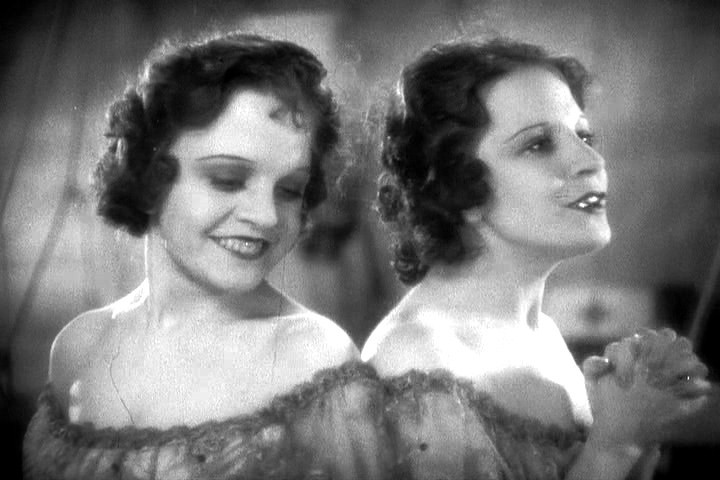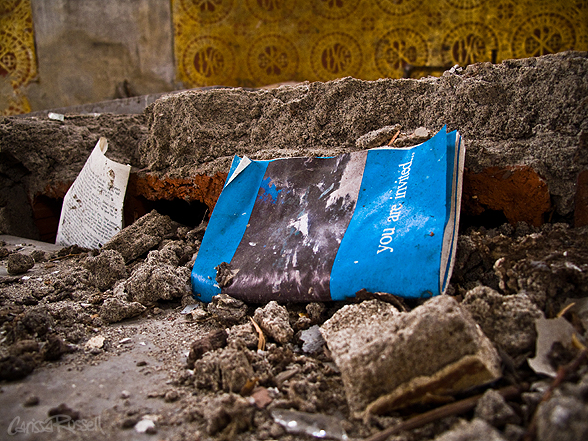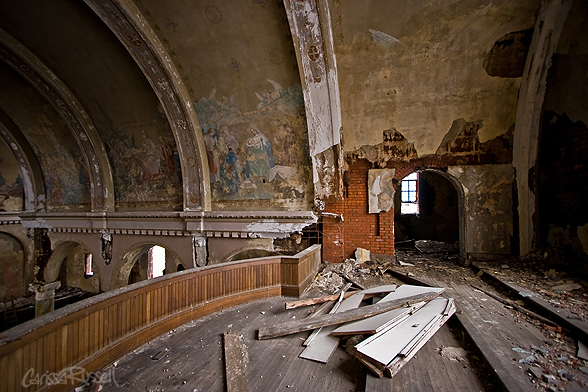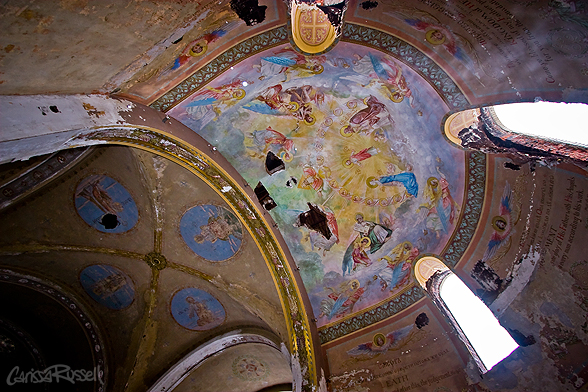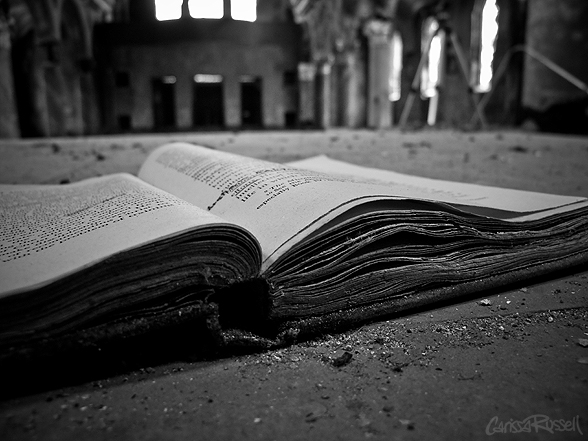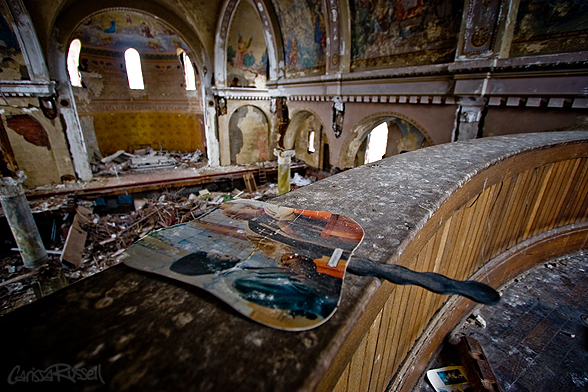lunes, 31 de mayo de 2010
jueves, 27 de mayo de 2010
But First they Must Catch You...
Etiquetas:
art
"All the world will be your enemy, Prince with a Thousand Enemies, and whenever they catch you, they will kill you. But first they must catch you, digger, listener, runner, prince with the swift warning. Be cunning and full of tricks and your people shall never be destroyed."
Richard Adams (Watership Down)
martes, 25 de mayo de 2010
Daisy and Violet Hilton
Etiquetas:
bizarre,
carneval,
circus,
Conjoined Twins,
Freaks,
historical,
Human Oddities,
Marvels,
sideshow
Original caption: Famous Siamese twins Daisy and Violet Hilton (of Freaks movie and sideshow fame) enjoy warm surf at Miami. (Feb. 25, 1945) Paul Colston Collection.
Contrary to popular belief, outright exploitation was not very common in sideshow. The majority of human marvels displayed themselves for their own reasons and quite often reaped massive financial and personal rewards for doing so. However, of the few performers who were exploited against their will, the tale of Daisy and Violet Hilton ranks as one of the worst.
 Daisy and Violet Hilton were born in Brighton, East Sussex, England on February 5, 1908 to a young, unwed barmaid, Their birth name was Skinner however their impoverished and unmarried mother, Kate, could not fathom the responsibilities involved in raising a pair of girls joined. She sold the twins to her boss and midwife Mary Hilton.
Daisy and Violet Hilton were born in Brighton, East Sussex, England on February 5, 1908 to a young, unwed barmaid, Their birth name was Skinner however their impoverished and unmarried mother, Kate, could not fathom the responsibilities involved in raising a pair of girls joined. She sold the twins to her boss and midwife Mary Hilton. The sisters were pygopagus twins - conjoined at the hips and buttocks. They shared blood circulation and were fused at the pelvis but shared no major organs. A medical account of the birth and a description of the twins was provided for the British Medical Journal by Dr James Augustus Rooth[1], the physician in charge at the time of their birth.
 He reports that subsequently the Sussex Medico-Chiurgical Society considered separation, but unanimously decided against it as it was believed that the operation would certainly lead to the death of at least one of the twins. He notes that these twins were the first to be born in the United Kingdom conjoined and to survive for more than a few weeks.
He reports that subsequently the Sussex Medico-Chiurgical Society considered separation, but unanimously decided against it as it was believed that the operation would certainly lead to the death of at least one of the twins. He notes that these twins were the first to be born in the United Kingdom conjoined and to survive for more than a few weeks. Soon after acquiring the twins, Mrs. Hilton put them on exhibition. They were managed by Ike Rose of Rose's Royal Midgets fame and exhibited alongside Rosa and Josefa Blazek, probably the first time in history that two sets of Siamese twins were ever shown together.
Daisy and Violet were later taken on an Australian tour with Mary Hilton, her husband Henry, and their daughter Edith. While in Australia, Edith married Myer Myers, a carnival balloon salesman.
 According to many sources, including the autobiography written by the Hilton sisters in 1942, Mary Hilton was a strict, physically abusive, exploitive and corrupt human being. The twins were ‘trained’ and ‘groomed’ to sing and dance in the vaudeville tradition.
According to many sources, including the autobiography written by the Hilton sisters in 1942, Mary Hilton was a strict, physically abusive, exploitive and corrupt human being. The twins were ‘trained’ and ‘groomed’ to sing and dance in the vaudeville tradition. While this training was in progress the horrific abuse and dehumanizing continued. When the girls finally began touring, they were seen as little more than possessions by the Hiltons.
The twins proved to be hugely successful and the toured extensively beginning at the age of three. On stage, the pair likely looked like dolls, their blond hair in curls and bows on their shoes. Violet played the piano while Daisy played the violin.
When Mary Hilton died, she willed the twins to Edith and Myer. The Myers relocated to the United States and used part of the twins' fortune to built a luxurious, Frank Lloyd Wright-inspired home in San Antonio, Texas.
Daisy and Violet spent the majority of the 1920s touring the United States on vaudeville circuits, playing clarinet and saxophone, and singing and dancing. The sisters were a national sensation, counting among their friends a young Bob Hope and Harry Houdini, who allegedly taught them the trick of mentally separating from one another.
Daisy and Violet spent the majority of the 1920s touring the United States on vaudeville circuits, playing clarinet and saxophone, and singing and dancing. The sisters were a national sensation, counting among their friends a young Bob Hope and Harry Houdini, who allegedly taught them the trick of mentally separating from one another.
Billed as ‘The United Twins’, their tours of Germany, Australia and the USA often saw record crowds. The twin brought in enormous amounts of money. Mary Hilton kept every penny.
When Mary finally died in Birmingham, Alabama, the guardianship of the twins fell to Mary’s daughter Edith and Edith’s husband, Meyer Meyers. They were even worse than Mary as they controlled every movement the twins made. They also proved to be poor agents as they insisted on keeping the girls ‘dolled up’ as little girl well past the age it was acceptable. Critics took notice and the twins were allowed to grow up, but only a little.
The mistreatment and corruption continued under the dictatorship of Edith. Edith purchased a mansion in San Antonio with the money the twins earned as a headquarters as the twins spent much of the 1920’s touring the United States on vaudeville circuits. It was on these circuits that they met Bob Hope and their dear friend Harry Houdini. Their popularity, at this point was near its peak and as a result they became subject to scandal.
The twins had befriended their advance agent, William Oliver. Oliver’s wife Mildred was suspicious of the relationship and accused William of improper acts. A postcard from the twins signed to William ‘with love’ prompted Mildred to file for divorce and sue the twins for $250,000. Oddly enough, this frivolous lawsuit was the catalyst for the Hilton’s freedom.
During a visit to San Antonio lawyer, Martin J. Arnold, the truth came out. As the Meyer’s were out of the room the Hilton sisters told the lawyer of their life of abuse and captivity. The lawyer was flabbergasted and immediately took on the twins’ case. He took the twins into protective custody.
In April of 1931 Judge W.W. McCrory awarded a large sum of money – some reports say as much as $100,000, to the sisters and granted the pair their freedom.
The girls had spent 21 years in abject slavery.
Daisy and Violet became citizens of the United States and returned to show business. They hosted their own show, ‘The Hilton Sisters’ Revue’, and stared in the 1932 film Freaks.
Everything seemed to be perfect in the life of the Hilton sisters; however the pair soon began to self destruct. Due to too many years of solitude, suppression and deprivation the girl wallowed in excess. They had numerous affairs, legal problems, clashes with that media and a couple of short publicity marriages. Their popularity nosedived.
 Violet had a string of highly publisized love affairs with celebrity boyfrinds, and became engaged in 1933 to bandleader Maurice L. Lambert. Violet and Lambert began a nationwide search for a clerk who would issue them a marriage license.
Violet had a string of highly publisized love affairs with celebrity boyfrinds, and became engaged in 1933 to bandleader Maurice L. Lambert. Violet and Lambert began a nationwide search for a clerk who would issue them a marriage license. Each of her requests - in 21 states - was denied on moral grounds, and lawyers were brought in to argue on Violet's behalf. One New York clerk refused to issue the license because Daisy was not also engaged. Though briefly engaged to Jack Lewis, another bandleader, she deemed him too shy for marriage to a Siamese twin.
Unable to get married, Violet and Maurice split. Two years later, however, the twins' agent Terry Turner announced that he could arrange for Violet to marry after all - she only needed a groom.
Chosen for the role was Violet's dance partner and a longtime confidant of the twins, James Walker "Jim" Moore. The wedding, such as it was, took place on July 18, 1936, at the Texas Centennial Exposition on the 50-yard line of the Cotton Bowl. Daisy, too, got to experience wedded bliss when she married vaudeville dancer Harold Estep, stage name Buddy Sawyer, at Elmira, New York, on September 17, 1941. Their marriage lasted two weeks.
Chosen for the role was Violet's dance partner and a longtime confidant of the twins, James Walker "Jim" Moore. The wedding, such as it was, took place on July 18, 1936, at the Texas Centennial Exposition on the 50-yard line of the Cotton Bowl. Daisy, too, got to experience wedded bliss when she married vaudeville dancer Harold Estep, stage name Buddy Sawyer, at Elmira, New York, on September 17, 1941. Their marriage lasted two weeks.
Original caption: Siamese Twins Daisy and Viola Hilton - Freak Siamese twins are capable of earning living in practical pursuits. These English-born twins have just come from San Antonio, Texas. Photo shows Daisy Hilton typing while her inseparable sister Viola sews. They are both accomplished typists, needlewomen, and are expert in the culinary art. (Photo by Underwood & Underwood, Nov. 29, 1924)
The sisters in the cafeteria of the Newhouse Hotel, Salt Lake City, Utah. They were scheduled to perform at the RKO theater.
After the decline of vaudeville, the twins, like countless others, turned to Hollywood. In 1950 the sisters appeared in the film Chained for Life as Dorothy and Vivian Hamilton, vaudeville singers. In the film, Vivian takes a dislike to the musician who is courting her sister.
Dorothy, on the other hand, is so smitten that she begs doctors to separate her from her twin so that she might marry. In the end, Vivian shoots and kills Dorothy's beau with a pistol grabbed from a sharpshooter's prop cart. The judge - and the audience - are left to decide whether to send innocent Dorothy to jail, or let guilty Vivian walk free. Chained for Life was a colossal failure, banned in many places due to its lurid subject matter.
Dorothy, on the other hand, is so smitten that she begs doctors to separate her from her twin so that she might marry. In the end, Vivian shoots and kills Dorothy's beau with a pistol grabbed from a sharpshooter's prop cart. The judge - and the audience - are left to decide whether to send innocent Dorothy to jail, or let guilty Vivian walk free. Chained for Life was a colossal failure, banned in many places due to its lurid subject matter.
 Struggling to survive, the twins opened a hotdog stand, The Hilton Sisters' Snack Bar, in Miami, in 1955, but the business failed in part due to the objections of fellow vendors.
Struggling to survive, the twins opened a hotdog stand, The Hilton Sisters' Snack Bar, in Miami, in 1955, but the business failed in part due to the objections of fellow vendors.The Hiltons’ last public appearance was at a drive-in movie theater in Charlotte, North Carolina in 1962. Their tour manager abandoned them there, as the tour was a failure and he was tired of losing money.
He left them without any money or transportation and the twins simply decided to settle in Charlotte. A kind grocery store manager hired the sisters to work in his shop, where they checked and bagged groceries.
He left them without any money or transportation and the twins simply decided to settle in Charlotte. A kind grocery store manager hired the sisters to work in his shop, where they checked and bagged groceries.
 On January 6, 1969, after battling the Hong Kong flu for some weeks, the twins failed to report for work. Their boss called the police and the sisters were found dead in their small trailer. Daisy died first and forensic evidence tragically suggested that Violet lived for two to four days afterwards.
On January 6, 1969, after battling the Hong Kong flu for some weeks, the twins failed to report for work. Their boss called the police and the sisters were found dead in their small trailer. Daisy died first and forensic evidence tragically suggested that Violet lived for two to four days afterwards.Having no surviving family, the twins were laid to rest beside a Vietnam soldier named Troy Thompson, the son of an acquaintance. At death, the twins owned but $1,000, a far cry from their formerly vast fortune. Those who met them late in life describe the quintessential "fallen stars": the twins spoke and dressed as they had in their heyday, well into the 1960s.
Despite the sad end to their lives, the memory of the Hilton sisters still lives on. In 1997, a Broadway musical loosely based on the sisters’ lives, Side Show, with lyrics by Bill Russell and music by Henry Krieger, received four Tony nominations.
lunes, 24 de mayo de 2010
The Galveston Giant
Etiquetas:
bizarre,
historical,
Marvels,
Men
Johnson was born in Galveston Texas, the third child and first son of Henry and Tina "Tiny" Johnson, former slaves who worked at blue-collar jobs to raise six children and taught them how to read and write. Jack Johnson had just five years of formal schooling. Johnson's father was born a slave in Tennessee. He dropped out of school after five or six years of education, to get a job.
 Johnson was known to always drive the very lastest automobiles, to the annoyance and anger of car dealers. Once, when driving well over the speed limit he was stopped by a policeman who fined him $50. Johnson handed him a $100 bill, saying he intended to make his return trip at the same speed.
Johnson was known to always drive the very lastest automobiles, to the annoyance and anger of car dealers. Once, when driving well over the speed limit he was stopped by a policeman who fined him $50. Johnson handed him a $100 bill, saying he intended to make his return trip at the same speed.
 Johnson was known to always drive the very lastest automobiles, to the annoyance and anger of car dealers. Once, when driving well over the speed limit he was stopped by a policeman who fined him $50. Johnson handed him a $100 bill, saying he intended to make his return trip at the same speed.
Johnson was known to always drive the very lastest automobiles, to the annoyance and anger of car dealers. Once, when driving well over the speed limit he was stopped by a policeman who fined him $50. Johnson handed him a $100 bill, saying he intended to make his return trip at the same speed.Johnson constantly flouted conventions regarding the social and economic "place" of Blacks in American society. As a Black man, he broke a powerful taboo in consorting with White women, and would constantly and arrogantly verbally taunt men (both white and black) inside and outside the ring. Johnson was pompous about his affection for white women, and imperious about his physical prowess, both in and out of the ring. Asked the secret of his staying power by a reporter who had watched a succession of women parade into, and out of, the champion's hotel room, Johnson supposedly said "Eat jellied eels and think distant thoughts".
A century ago, for the first time in U.S history, two champions- one reighning, the other retired but undefeated- were about to square off to determine the rigtful heavyweight king of the world. But more than a title was at stake.
In one corner was James Jackson Jeffries, the "Boilmaker" who had retired undefeated six years earlier, he was six feet one and a half inches tall, and weighed 277 pounds.
In the other corner was John "Jack" Johnson, the "Galveston Giant" who had taken the title a year and a half before, beating the other fighter so badly that the referee stopped the fight in the 14th round.
Jeffries was urged by Jack London to "emerge from his Alfalfa farm and remove that smile from Johnson's face."
The New York Times editorial summed up a common view "If the black man wins, thousands and thousands of his ignorant brothers with misinterpret his victory as justifying claims to much more than physical equality wiht their white neighbours."
Jeffries was blunter "I am going into this fight for the sole purpose of proving that a white man is better than a negro."
 The Johnson-Jeffries fight was of such intense interest that it was filmed to be shown in movie theaters worldwide. Once it became clear in the early rounds, that the once-fearsome Jeffries couldn't hurt him, Johnson toyed with his opponent, keeping up a running steam of commentary directed at Jeffries, and at Jim Corbett in Jeffrie's corner. Corbett had showered Johnson with racist incentive from the moment the fighter entered the ring, and the majority of the crowd had joined in. Many were calling for Jeffries to kill Johnson.
The Johnson-Jeffries fight was of such intense interest that it was filmed to be shown in movie theaters worldwide. Once it became clear in the early rounds, that the once-fearsome Jeffries couldn't hurt him, Johnson toyed with his opponent, keeping up a running steam of commentary directed at Jeffries, and at Jim Corbett in Jeffrie's corner. Corbett had showered Johnson with racist incentive from the moment the fighter entered the ring, and the majority of the crowd had joined in. Many were calling for Jeffries to kill Johnson. Even though blacks and whites met in the ring, the heavyweight title was considered sacrosanct, a symbol of white superiority. Thus Johnson’s demolition of Tommy Burns in 1908 stunned the sporting world, which shunned him as the legitimate champ. Since Jeffries had retired undefeated, the only way Johnson could place his title beyond dispute was to beat Jeffries in the ring.
 Instead, Johnson’s swift jab and eviscerating counterpunches began to take their toll as Johnson turned the tables on his tormentors. “Don’t rush, Jim. I can do this all afternoon,” he said to Jeffries in the second round, hitting the big man again. “How do you feel, Jim?” he taunted in the 14th. “How do you like it? Does it hurt?” Dazed and bleeding, Jeffries could barely keep his feet, and Corbett fell silent. In Round 15, Jeffries went down for the first time in his career. Johnson hovered nearby—there were no neutral corners in those days—and floored the former champ again the minute he regained his feet. Now a different cry went up from the crowd: Don’t let Johnson knock Jeffries out. As Jeffries went down yet again, knocked against the ropes, his second jumped into the ring to spare his man, and the fight was over. The audience filed out in near-silence as Tex Rickard raised Johnson’s arm in triumph; across America, blacks poured into the streets in celebration. Within hours scuffling broke out in cities across the country.
Instead, Johnson’s swift jab and eviscerating counterpunches began to take their toll as Johnson turned the tables on his tormentors. “Don’t rush, Jim. I can do this all afternoon,” he said to Jeffries in the second round, hitting the big man again. “How do you feel, Jim?” he taunted in the 14th. “How do you like it? Does it hurt?” Dazed and bleeding, Jeffries could barely keep his feet, and Corbett fell silent. In Round 15, Jeffries went down for the first time in his career. Johnson hovered nearby—there were no neutral corners in those days—and floored the former champ again the minute he regained his feet. Now a different cry went up from the crowd: Don’t let Johnson knock Jeffries out. As Jeffries went down yet again, knocked against the ropes, his second jumped into the ring to spare his man, and the fight was over. The audience filed out in near-silence as Tex Rickard raised Johnson’s arm in triumph; across America, blacks poured into the streets in celebration. Within hours scuffling broke out in cities across the country.The next day, the nation’s newspapers toted up the carnage. The Atlanta Constitution carried a report from Roanoke, Virginia, saying that “six negroes with broken heads, six white men locked up and one white man, Joe Chockley, with a bullet wound through his skull and probably fatally wounded, is the net result of clashes here tonight.” In Philadelphia, the Washington Post reported, “Lombard Street, the principal street in the negro section, went wild in celebrating the victory, and a number of fights, in which razors were drawn, resulted.”
In Mounds, Illinois, according to the New York Times, “one dead and one mortally wounded is the result of the attempt of four negroes to shoot up the town....A negro constable was killed when he attempted to arrest them.” In all, as many as 26 people died and hundreds were injured in violence related to the fight. Almost all of them were black.
In the following days, officials or activists in many localities began pushing to bar distribution of the fight film. There were limited showings, without incident, before Congress passed a law forbidding the interstate transportation of boxing films in 1912. That ban would hold until 1940.
With some of the winnings from the fight, he opened the Café de Champion, a Chicago nightclub, and adorned it with Rembrandts he had picked up in Europe. In October 1910, he challenged race car driver Barney Oldfield and lost twice on a five-mile course at the Sheepshead Bay track in Brooklyn. (“The manner in which he out-drove and out-stripped me convinced me that I was not meant for that sport,” Johnson would write in his autobiography.)
And he continued dating, and marrying, white women. His first wife, Etta Duryea, shot herself to death in September 1912. Later that fall, he was arrested on a bogus charge under the Mann Act, the 1910 law that prohibited the transportation of women across state lines for “immoral purposes.” (The arrest did not prevent his marriage to Lucille Cameron, a 19-year-old prostitute, that December.) Tried and convicted in 1913, he was sentenced to a year and a day in prison.
Rather than face jail, Johnson fled to France, where he defended his title against a succession of nonentities. He finally lost it in another outdoor ring under a broiling sun in Havana in 1915 to Jess Willard, a former mule seller from Kansas who had risen to become the leading heavyweight contender. Once again, the heavyweight division had a white champion.
In 1920, Johnson returned to the United States to serve his year in prison. Released on July 9, 1921, at age 43, he fought, and mostly lost, a series of inconsequential fights. In 1923, he bought a nightclub on Lenox Avenue in Harlem, Jack Johnson’s Café de Luxe; the gangster Owney Madden took it over and transformed it into the famed Cotton Club. Divorced from Lucille in 1924, Johnson married Irene Pineau, who was also white, a year later. In 1946, racing his Lincoln Zephyr from Texas to New York for the second Joe Louis-Billy Conn heavyweight title fight at Yankee Stadium, he hit a telephone pole near Raleigh, North Carolina. It was the only crash Jack Johnson failed to walk away from. He was 68."
sábado, 22 de mayo de 2010
All are Welcome Here
Etiquetas:
abandoned,
beautiful ruin,
churches,
decay,
Haikyo,
photography
“Being confident of this very thing, that He who has begun a good work in you will complete it..."
Philippians 1:6
Source
Suscribirse a:
Entradas (Atom)




























